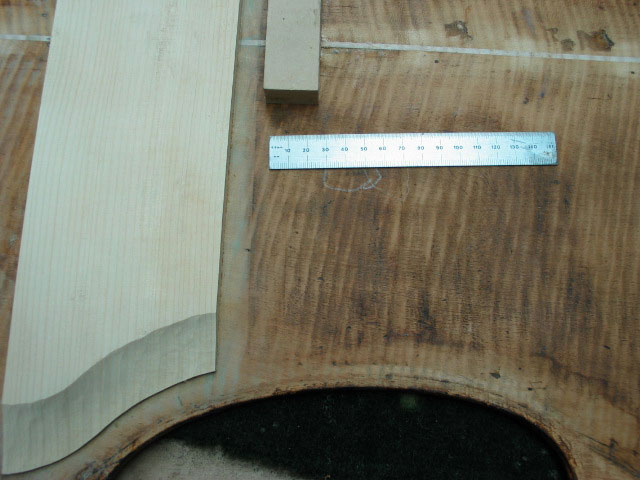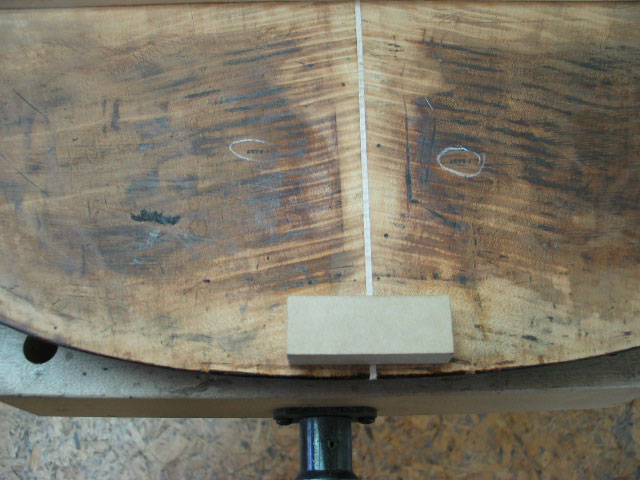
 |
|
|
|
#1
|
|||
|
|||
|
Quote:
|
|
#2
|
||||
|
||||
|
Quote:
   As you can see, the blocks were left in till after the crossbars were glued in and taken out only when.. Arnold? (you tell him..  ) ) |
|
#3
|
|||
|
|||
|
Ok now what to do .... ?
The back fit is textbook ie a healthy amount of overhang all round . If I clamp the neck and end blocks to the back it maintains perfect symmetry so I believe that with an extra pair of helping hands I will get the fit correct without having to apply unnecessary distortion to the ribs. The gap you see at the lower bout join was originally filled with some wood that I removed / the gap must have been man made to try and cover up for some damage or something / i.e it is not caused by shrinkage etc.. My question is do I refill the gap with wood as was or plane the gap to an even width and insert a strip like on the pic Ken posted . Obviously cosmetically the latter is the proper option or ? |
|
#4
|
||||
|
||||
|
I'd be inclined to re-joint the back and put a tapered strip in. Heck I'd probably use ebony or something!
 If the rest of the joint is already solid though, I guess you could inlay a slice into the gap - but it wouldn't look as nice and probably wouldn't be as solid long-term... Basically I'd un-do everything and make the back perfect, then go from there. Since you have the top and back both off (right?), getting the back to be a nice perfect platform should be a lot more pleasant when you're putting things back together! |
|
#5
|
|||
|
|||
|
Another way is to restore the top, then to make a template from it, maybe with thick plywood, then to glue the ribs on the template, only at blocks, temporary, then to decide what to do with the back, then to restore the back and glue it on the ribs, then to remove the template and glue the top. this way you can widen (or not) the back to follow the top shape. Also, the top-ribs joint is usually flat, while the back is bent.
My two cents, good luck. |
|
#6
|
||||
|
||||
|
Usually once I take the top or back off, I keep the corners and blocks into position with a sheet of 4mm plywood. Cheap and simple. A small screw through the ply into the face of each block holds everything in position until i'm ready to replace.
Jointing a back with a bend or curve in it, is tricky. You can't just line them up on a tabletop. I note Arnold's temp block method which I 'll have to try. Last one I did, I built a pair of cradles to which I tack-glued the back pieces. This allowed me to align them on a flat surface, plane the edges and clamp the insert simply and accurately.     ... and before anyone says anything about the alignment of the upper bout in the next picture, this was just the two sides pushed up against each other before glueing!   |
|
#7
|
||||
|
||||
|
Matt, the work looks good.
Adrien, being that you can see the bass in person and we can't you have to decide the method of attack. Personally, I think a complete re-joint of the center with an even strip in the middle would look best and be the safest way to go. This way, you can trust the joint you made. If not and it fails again where you didn't touch it, then it's back to square one again. Do it once and do it good. |
|
#8
|
|||
|
|||
|
[quote=Matthew Tucker;21282]Usually once I take the top or back off, I keep the corners and blocks into position with a sheet of 4mm plywood. Cheap and simple. A small screw through the ply into the face of each block holds everything in position until i'm ready to replace.
Jointing a back with a bend or curve in it, is tricky. You can't just line them up on a tabletop. I note Arnold's temp block method which I 'll have to try. Last one I did, I built a pair of cradles to which I tack-glued the back pieces. This allowed me to align them on a flat surface, plane the edges and clamp the insert simply and accurately. Nice work !!! Thanks for the pics  PS-is Warne really making a comeback ? |
 |
| Currently Active Users Viewing This Thread: 5 (0 members and 5 guests) | |
|
|